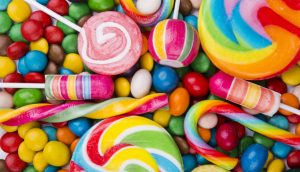3 answers for the Candy Craze
I’ve been reading about this Skittles spill and quite honestly, I was shocked. I had thought it would turn out to be a positive article for agriculture-using up food ingredients and preventing them from going into a landfill. But no! Consumers were upset that cows were fed “junk food”.
“Junk” to people doesn’t always mean that it is junk to cows. It’s hard to argue with folks that have their mind made up one way or another-and lately, facts just haven’t seemed to matter. Nevertheless, below are a few facts about feeding candy that you may find useful:
1. Cows are athletes and need a lot of calories to produce milk.
It’s crazy how many calories it takes a cow to produce milk. In fact, so many calories that we measure it in Mcals. Here’s how that breaks down: a Mcal is 1000 kcal and 1 kcal equals 1000 calories. A cow producing 100 pounds of milk needs 9.13 Mcals for maintence and another 31.57 Mcals to produce the milk. You do the math.
A cow eats a lot, which helps her calorie intake, but we also need to supply a sufficient amount of carbs to meet the energy level that she requires. Sugar-including candy-is one way to get there.
In contrast, a long distance runner will consume around 4000 calories a day. If a runner doesn’t take in the calories that they need,they can become fairly ill quickly. To meet this need, runners will consume straight glucose (sugar) from gel tubes.
2. Any excess can be a problem
We typically recommend 2 pounds of supplemental sugar maximum per cow per day. One pound of sugar equals 1670 calories-a drop in the bucket for cows. Yet, sugar is such a fast digesting carbohydrate that the amount is limited-to ensure proper digestion and prevent acidosis. We limit the supplemental sugar to less than 4% of her daily diet.
The average American eats 86 grams of sugar a day-about 66 pounds per year. This represents 16.7% of the average calorie intake per day-that’s the problem with sugar and people-just too much!
3. It is beneficial for cows to receive a variety of energy sources
Energy sources, such as carbohydrates, are digested at different rates. Sugar is rapidly broke down by the rumen bacteria and can increase the protein in the milk. Starchs are moderate digesters and fiber is slowly digested-all three have a role for healthy, high producing cows.
People digest some of these carbohydrates at different rates as well-we call them high or low glycemic and soluble fiber. Some of them, because we can not utilize all the fiber a cow can digest. But we need a balance too. The problem is, we like sugar and aren’t as active as cows to balance it all out.
Skittles, by the way, is 90.67% sugar-a good value compared to whey permeate (50-70%) or molasses (35-45%) . Just try to keep away from them yourself and feed them to the cows instead.
